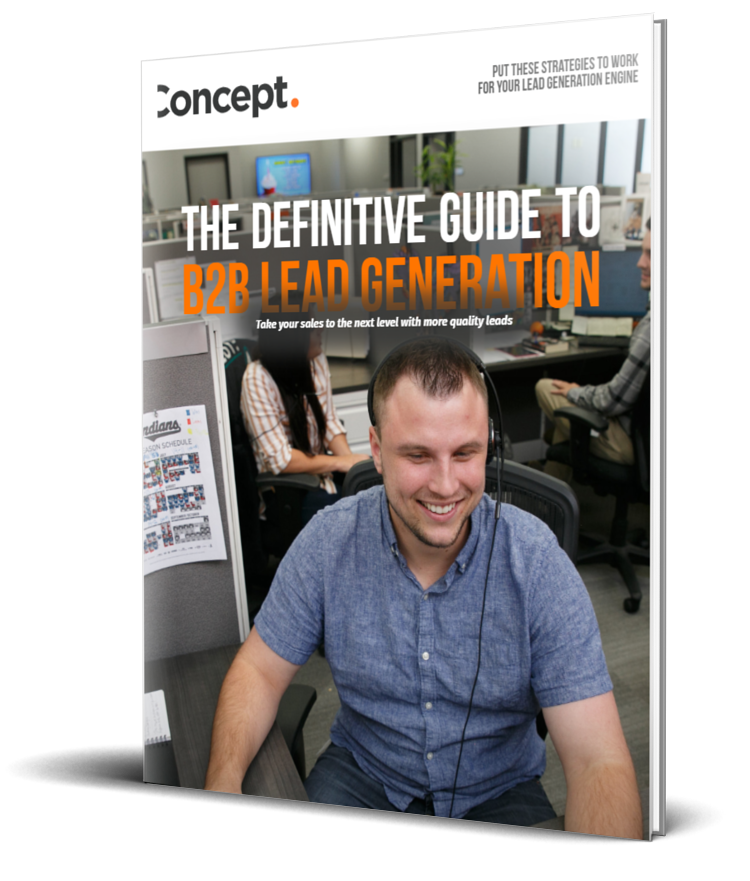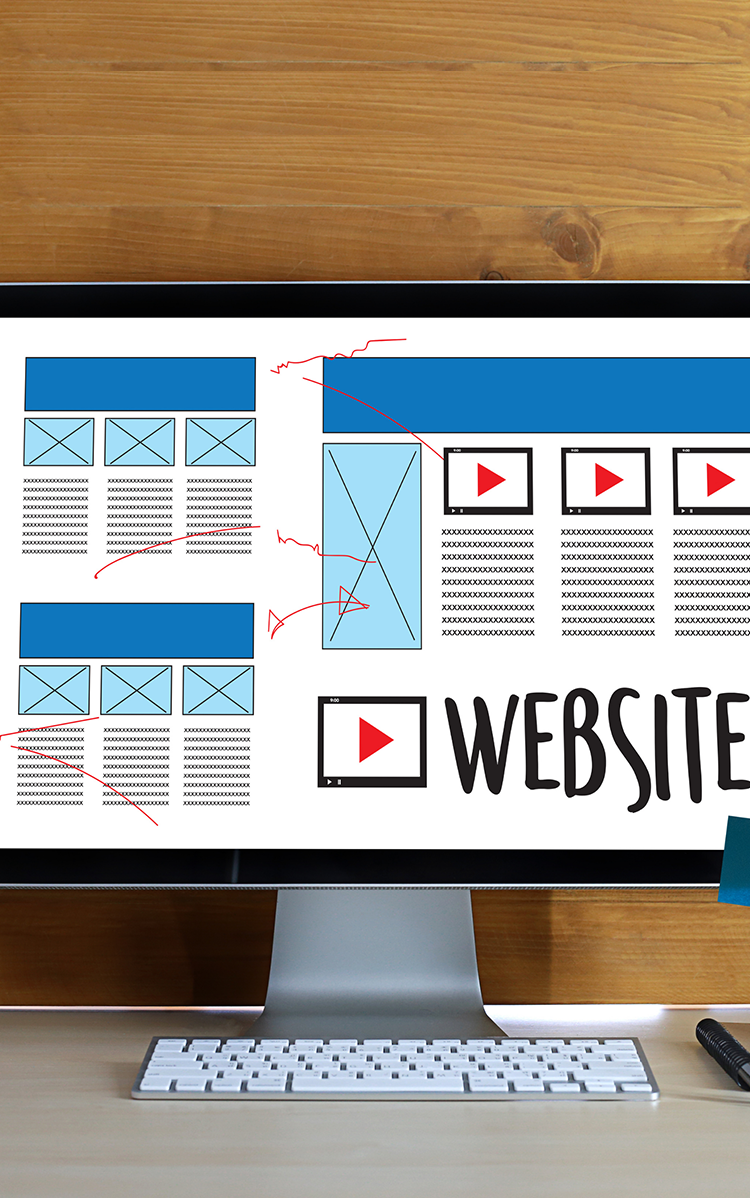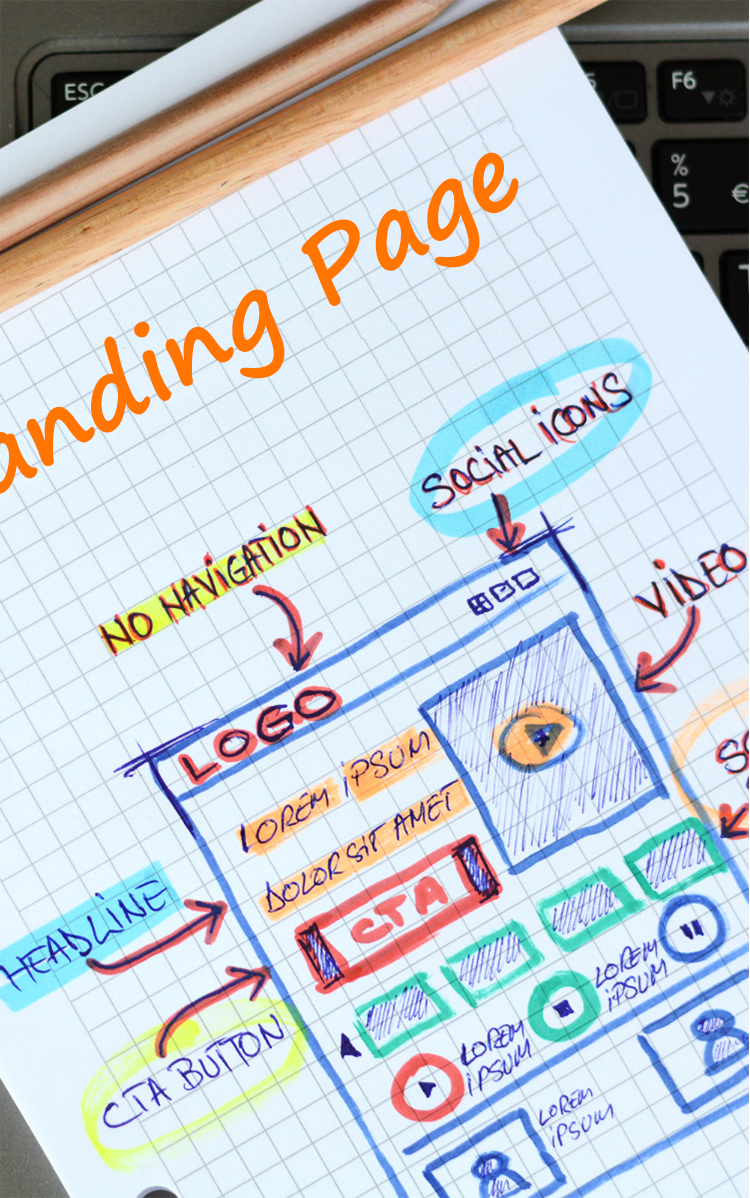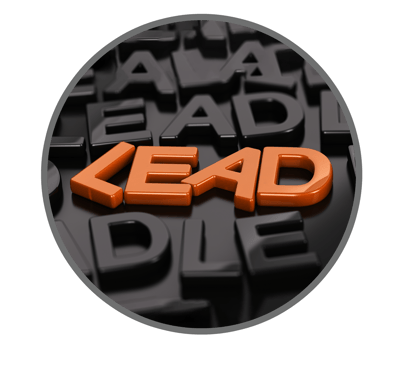Definitive Guide to B2B Lead Generation
Take Your Sales to the Next Level with More Quality Leads
B2B Lead Generation
If your company sells B2B and is looking to grow its sales pipeline, you have come to the right place to better understand B2B lead generation. In this guide, you will find all you need to know to build a successful and scalable lead generation engine.
eBook Download
Download our B2B Lead Generation eBook to read later!

What is B2B Lead Generation?
B2B lead generation is the process of identifying, qualifying, and capturing potential buyers for your company’s product and/or service to drive future sales and is essential for every B2B company.
Virtually every sale to a new customer will begin with the generation of a qualified lead.
B2B leads are in short supply compared to those for B2Cs. Therefore, B2B companies need to work harder to stand above their competition and gain the attention of their potential customers.
 How to define a lead?
How to define a lead?
So, you need more sales leads… But what exactly is a sales lead? We have seen companies using a variety of definitions for leads over the years including:
- Company and contact
- Company, contact, and specific information found
- Company, contact, specific information found, and willing to meet or talk
- Company, contact, qualified based on your defined criteria, and willing to meet or talk
- Company, contact, qualified based on your defined criteria, has a need, willing to meet or talk
- Company, contact, qualified based on your defined criteria, ready to buy now, and willing to talk
There is no one-size-fits-all definition of a lead. In fact, all the definitions above can be considered a lead, but in varying lifecycle stages of their buyer journey.
Before moving down the path of generating more B2B leads, you first need to start with defining what a sales-ready lead means to your company. Defining this is not something that can fall exclusively on the marketing or sales group. Lead criteria is best done by gaining a consensus from the sales team, marketing group, and senior executives on how your business is classifying B2B sales leads and tracking them.
Having an unclear definition of what is a sales-ready lead is the quickest way to lead generation failure.
Lead Generation Strategies
There are a variety of strategies when it comes to generating B2B leads. When deciding what method is best for you, a good place to start is the evaluation of your Message, Audience, and Channel(s).
Have your evaluated your organization's:
- Message – What are you trying to communicate to a prospective customer that would get their attention?
- Audience – What is the Ideal Customer Profile (ICP) and Buyer Persona of the person you are trying to share this message with?
- Channel(s) – What are the best channel(s) to reach your ideal customer?
After going through the evaluation of message, audience, and channel, the next step is deciding which approach is most right for your business including:
- Inbound – Inbound Lead Generation involves creating content that attracts, converts, and delights customers.
- Outbound – Outbound Lead Generation involves reaching out to a target audience, regardless of whether they have expressed an interest. With outbound, it is you, not the prospect, who chooses the time and place of the interaction.
- Account-Based Marketing (ABM) - Account-based marketing is a highly targeted, focused growth strategy. It works by aligning marketing and sales functions to create a personalized experience for accounts, rather than an individual buyer.
Each approach has its own set of benefits and drawbacks and it is encouraged to have a blend of each strategy in your overall lead generation efforts.
Concept Pro Tip: Lead Generation Strategy
It is extremely common for companies to generate most of their leads and sales from one channel. However, that is usually a product of not maximizing the other channels that are available, not because they are ineffective. In most situations, the right answer is to use a healthy mix of the channels that are best for your target audience.
What is Demand Generation?
While closely related, lead generation and demand generation are often mixed up and have their own (mutually supportive) goals.
When developing an Inbound or ABM strategy, a step that is often overlooked is demand generation. Demand generation is a data-driven marketing strategy that creates awareness of and interest in a company's offerings using technology. If you are going to have any success in generating inbound leads, you need to have a good supply of right-fit prospects turning up to your website and landing pages. This is where demand generation comes in.
Effective demand generation campaigns should find a challenge that your prospects have and show how your organization can solve the problem for them. It is proactive and targeted by nature.
Several demand generation tactics include:
- Search engine marketing (also known as PPC or paid search)
- LinkedIn ads
- Display advertising
- Direct mail
"A lead cannot just be defined by sales, or marketing, or one, singular group within an organization. Input needs to be given by sales, marketing, customer success, etc. to make sure everyone is working towards the same goal. "
Jeff Harsh
President
Lead Generation Tactics
A lead generation campaign has the goal of converting interest and engagement into leads for your business. It is important to note that regardless of tactic, lead generation is not a one step process.
There are usually multiple touchpoints where attention is gained, interest raised, and then the decision to interact is taken.
These interactions can take place across a variety of mediums including outbound phone calls, emails, your website, social media, paid advertising, and more. Effective lead generation combines varying tactics into campaigns that drive leads consistently over time.
The lead generation channels you choose are only significant if they target the ideal customer profiles and buyer personas that have already been defined. They are the places where your ideal customers hang out, as well as any campaigns you run using lookalike audiences and retargeting.
Several lead generation tactics include:


Outbound 1-to-1 Phone & Email Prospecting
While there are a variety of digital lead generation options available, if your company has a strong message and value proposition along with a defined Ideal Customer Profile (ICP) and buyer personas, simply picking up the phone or sending a 1-to-1 email to create opportunity can be one of the most effective ways to generate qualified sales leads for your organization.
Email can be an extremely powerful lead generation strategy. However, there is often a big obstacle many companies face when trying to do effective email marketing… Do I have a database of qualified contacts from accounts within my ICP with email addresses? Without a qualified database, your email marketing efforts will surely fall flat and would recommend spending time developing and growing your database.
If you do have a strong database of qualified contacts with email addresses, the next question you need to ask is… What is the goal of my email marketing efforts when it comes to lead generation?
Depending on your goal, ensuring that you have the right technology in place to measure the effectiveness of how your email marketing efforts are carrying out your goal is key.


Website
Your website is a key pillar of lead generation strategy. Many of your lead generation efforts will be designed to ultimately steer a prospect to visiting some part of your website to learn more about a specific topic or your company. Your website needs to be easy to navigate, have a good overall user experience, and clearly communicate what your company does.
A frequent company website miss is not showcasing your company’s personality so that prospects are confident when interacting with you. Help them to gain confidence in your company by supplying social proof in the form of reviews, testimonials, and case studies.
Once a prospect gets to your website, if they are able to clearly understand what your company does and gain confidence in how you may be able to help them, you need to provide them with varying different call-to-action (CTA) options on how they can exchange or share their information and engage with your company.
Some recommended ways include:
Landing Pages
Landing pages are singular pages are designed to receive and convert traffic from an online marketing campaign. Unlike other web pages, the extra page elements you would normally see such as navigation options and other links are removed to drive a single action. An effective landing page generally has as a prominent offer combined with a form or type of call-to-action (CTA).
The content of these offers can vary and is completely dependent on what your prospects find valuable. Understanding the needs, motivations, and wants of your prospective customers will help you to devise powerful offers. These offers can include things such as:
- Schedule an appointment
- Events/webinars
- e-Books
- Guides
- Whitepapers
- Case studies
Landing pages that are effectively designed to drive a desired call-to-action typically include things such as further description, benefits, testimonials, and background information to help drive conversion.


Blogs
Successfully integrating a blog into your B2B marketing and lead generation strategy can bring with it a wide range of benefits, from increased leads to improved brand awareness. Businesses that run and support a blog, posting regularly on topics relating to their business and industry are notably more successful at generating leads.
When it comes to B2B, having a strong blog can help in a variety of ways including:
Social Media
Social media can be another great source of leads, help in working leads through the sales funnel, create brand awareness and engagement, and even follow-through on capturing or nurturing leads.
Posting your content and target promotions based upon demographics, business details and marketplace or even Bio text depending upon the network you choose can help you grow your own audience.
Marking your posts with relevant hashtags or using groups is another way to use social media to reach a wide range of prospects who are already interested in your field. Both tactics aid in finding people who have interests in your industry.
When using social media, it’s important to remember that these tools are designed to be engaged with, not as a bulletin board. Get creative with your posts and encourage interaction. The more interaction your posts get, the farther the reach.


Website Live Chat
With many of the tactics mentioned above most likely resulting in a prospect eventually visiting your website or landing page, it is important to also consider the role of B2B live chat in your lead generation engine. Today’s buyers often spend time educating themselves via the web and if your demand generation efforts are working effectively, a prospect will find themselves on your site looking for useful content. If you are unable to convert them during that search, many will disappear, never to be seen again.
This is where live website chat can fill a crucial void. Prospects will not only appreciate the value of the immediate personal outreach but can ask and get questions answered on the fly, thus qualifying the visitor in a way no automation tool can. In many cases, chat can aid in moving your prospect down the sales funnel to MQL or beyond, generating tangible, measurable ROI from your site traffic. Without it, you may have lost them.
Concept Pro Tip: Lead Generation Tactics
Similarly, to the channels available for generating leads, the tactics that can be used are almost infinite. Prospects are all different, and their communication preferences and online habits can be a wide range. This makes it difficult to narrow down on a few channels to maximize communication with your target audience. Selecting the right lead generation channels all comes down to your target audience. Research and industry knowledge are crucial to this step because you want to be in the right place to communicate with your prospects and customers. A good first step is developing both short-term and long-term strategies on generating new leads, then use the right channels to communicate that message. For example, paid search is a good strategy for short-term impact because these leads are typically further along in their buying process. However, it is much more difficult to qualify right-fit prospects so the conversion rate to a customer is lower. That is why you need to pair it with a long-term strategy to have a sustainable process.
What is Lead Nurturing?

One of the most common problems that organizations struggle with is not the generating of leads, but rather the ongoing nurturing and progressing of leads to a sale.
With an effective demand generation and lead generation strategy, you now have started to build a reliable database of leads. However, as mentioned above, lead generation is not a one-step process. The steps needed to qualify, and progress leads from a captured name to a qualified sales-ready lead are equally as important as generating the lead itself and often where many companies fall short.
Think about your lead generation funnel as a bucket. Your sales team is asking for you to fill their sales funnel up with qualified sales-ready leads. While creating demand and generating leads are the first steps, if you put all of your focus in generating and no focus on progressing, you will never be able to fill the sales team bucket up because leads keep leaking out of the funnel due to ineffective lead nurturing and progressing.
Effective lead nurturing has multiple sides requires the ability to segment out where leads are in their buyer journey or lifecycle and staying in front of those leads at the right time and through the use of the right channel. Defining your lifecycle stages is the first step.
Lead Lifecycle Stages
A good question to ask when defining what a lead is for your organization is:
“What level of lead qualification is required before the handoff occurs to sales?”
Once this is defined, you can reverse engineer the ownership of leads that are not yet qualified to meet your company’s criteria between marketing and sales development teams to nurture and touch throughout the journey leading up to the handoff to sales. Doing this effectively requires both a clear definition of what a lead is and your CRM & Marketing Automation tools being mirroring this progression to be able to properly segment.
Properly categorizing your leads, knowing the difference between each stage, and what triggers a move from one stage to the other is essential to effectively move through the funnel.
Companies will often segment their lifecycles differently, but in our experience the simpler the process and definition, the more effective it can be managed. A simplified model of how to do this reverse engineering exercise could be:
- Sales Qualified Lead (SQL) – These are “hot” bottom-of-funnel (BOFU) sales-ready-leads that meet the defined criteria set by your organization and are handed over to sales team.
- Marketing Qualified Lead (MQL) – These are “warm” middle-of-funnel (MOFU) leads who have engaged with the team's marketing and/or sales development efforts but are still not ready to speak with the sales team or qualify as a SQL.
- Information Qualified Lead (IQL) – These are “cold” top-of-funnel (TOFU) leads or contacts who have been identified in CRM and Marketing Automation tool, but enough information has not been gathered or engagement has taken place to qualify them as an MQL.
As your organization continues to evolve your lead generation program, more sophisticated and complex lifecycle stages may be needed. However, using the “crawl, walk, run” method when developing is recommended.
Concept Pro Tip: Lifecycle Stages
The primary goal of developing life-cycle stages is to track the progress of leads through the sales process. If you do not define when a lead should transition to a sales rep from marketing, it will be much harder to figure out how to get more sales-qualified leads in the future. These need to be defined metrics that both sales and marketing handle so they can drive towards a common goal.
What is Lead Scoring?
Lead scoring is the process of assigning values, often in the form of numerical "points," to each lead your business generates. Leveraging lead score can bring with it quantitative segmentation to allow for you to more easily bucket into appropriate lifecycle stages.
Lead scoring can be based on a variety of attributes, including demographic information, company information, online behavior, email engagement, social engagement and more. In addition to positive attributes driving lead score up, there can be negative attributes that reduce from lead score. This process helps sales and marketing teams prioritize leads, respond to them appropriately, and increase the rate at which those leads become sales.
Every company has a different lead scoring model based on their business. Effective lead scoring is not a “set it and forget it process”, but continuously evaluated and optimized.
“How do I set up lead scoring for my company?”
Like lifecycle stages, keeping things simple early in the process is the best place to start. First, analyze your existing contacts who became customers to see what they have in common. Second, analyze the contacts who did not become customers. After reviewing the attributes from both sides, you can begin to decide which attributes should be included and how they should be weighted based on how likely they are to show someone is a good fit for your product. More sophisticated lead scoring models will require a more robust means of capturing lead data.
With Lifecycle Stages and Lead Scoring in place, your organization can begin to segment out and put specialized focus and nurture plans in place to stay in front of each lead every step of the way.
When building a lead nurturing process, having the right systems and technology in place can allow for you to do this effectively at scale.
Nurturing and progressing does not stop at the lead level, ultimately the goal of lead generation is to generate an opportunity and result in a sale. Making sure your sales team is equipped and effective at following up with doing an effective discovery with a prospect is also an essential piece.
Concept Pro Tip: Lead Scoring
The most important thing about lead scoring is to use a method that works for you. If a prospect opening a marketing email doesn’t affect whether or not they become a customer, then it shouldn’t change their lead score.
Start simple with lead scoring, it doesn’t have to be complicated in order to be impactful.
Lead Generation Technology
What technology is needed for effective lead generation and lead nurturing?
Customer Relationship Management (CRM) Software
- CRM software is the most important technology that a business can use to build a scalable lead generation engine. Without a CRM, you are starting from nothing every time you reach out to a prospect or relying on the tribal knowledge of your sales team to bring you up to speed. Having a CRM allows team members to log information about each interaction they have with prospects or customers, while also capturing valuable marketing intelligence that can be used across the organization.
Marketing Automation/Email Marketing Tools
- In 2021, it’s extremely difficult to execute a successful campaign without the help of automation. Automatically completing repeatable tasks can help free up your team to do what they do best.
Sales Automation Tools
- Software like HubSpot Sales Hub or LinkedIn Sales Navigator reduces time spent on tasks like updating CRM records or inputting data on leads and increases the amount of time spent on sales-critical activities.
Website Content Management System (CMS)
- Content for a website can be managed through an online system that is stored in a database and displayed in a presentation format and based on a set of templates.
Search Advertising Accounts
- If you plan on utilizing paid search or paid social advertising for your lead generation activities, some advertising platforms offer some type of central management hub like Campaign or Ads Manager. This gives you the ability to see ads and keyword performance in one central location.
Blog Platform
- Similar to CMS, a platform to host and build your blog posts reduces time spent on technical execution and sends notifications to blog subscribers for each new post published.
Social Media Accounts
- Another feature of the Campaign Manager for paid social advertising is that it allows you to manage your organic social posts and performance from one place.
Data Tools
- If you're looking for better information about a company's earnings, size, or SIC code, working with software from Dun & Bradstreet or ZoomInfo can help fill in any gaps.
Phone System
- Using a phone system like Nextiva or RingCentral that can integrate with your CRM and allows call recording, real-time data reporting like the number of calls made, duration of calls, activity by time of day, and more improve sales efficiencies.
In Conclusion
We know that B2b lead generation is a vast topic. Below are some other informational resources.
Concept
One of the nation's most experienced outsourced B2B lead generation and appointment setting agencies
- outbound sales development,
- digital marketing, &
- technology services.

Get the Inside Scoop
Learn More from Our B2B Blog
The "No-Show" Epidemic: How to Ensure Your Appointments Actually Happen
| December 22, 2025
You've done the hard work. Your B2B appointment setting process generated qualified leads. Your sales team scheduled discovery calls. Then the..
How to Build a HubSpot Dashboard Your CEO Will Actually Look At
| December 22, 2025
Most HubSpot sales reports gather dust. Despite hours of setup, executives rarely open them. Why? Because they’re built for sales managers, not CEOs...
HubSpot Smart Content: Personalizing the Website Experience for B2B
| December 22, 2025
HubSpot Content Hub enables website personalization through Smart Content: dynamic page elements that change based on who’s viewing them. Instead of..

